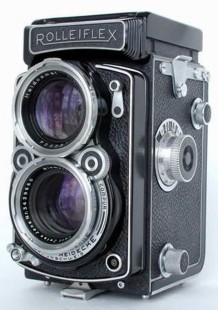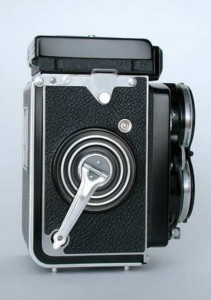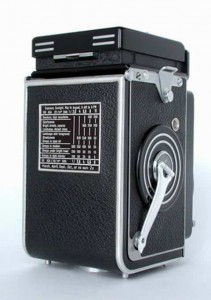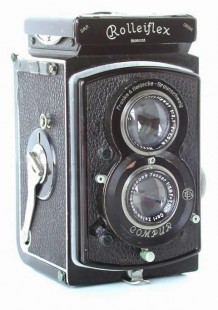Several members have expressed interest in the article that appeared in the PCCGB magazine 'Photographica World' in 2007 (issue 3) and wondering if it could be reproduced here for the benefit of a wider audience. This I have thought about quite carefully, but have been reluctant to take this step for several reasons: The author (John Phillips) is resident in New Zealand. The international copyright position is not totally clear and whilst the author, during his lifetime, would probably adopt a benign approach towards fellow camera users and collectors, experience shows that executors or similar do not necessarily adopt the same view. Neither Club Rollei nor John Wild and I, on a personal basis, have the resources to tackle some debate with family, lawyers or bankers on the other side of the world over what would in reality be a 'de minimis' issue.
The article is in part a promotion for a book the author was writing, said to be published in late 2007. I have seen nothing of it in the UK, so if it found its way into print we must assume it was only sold locally (since published and David Morgan reviews 'The Classic Rollei - A Definitive Guide" in CRU issue 20). For the European market, the various books by Ian Parker and Claus Prochnow have in any case covered the story of Rollei comprehensively. The article seems to focus on various previously published material which in John Phillips's view (correct, I think) is inaccurate concerning Rollei and its products but gives no credit to Messrs Parker and Prochnow who put in a great deal of hard work to bring us a more reliable account. It would naturally be interesting to see another person's slant on the last 90 years but I am not sure anyone could be better placed than the 'two Ps' to ascertain the facts.
So, what of the 2.8B? Prochnow captures succinctly the key facts, namely that it is an f2.8 TLR of the Rollei Automat type, manufactured from February 1952 to March 1953 with an 80mm Carl Zeiss Jena Biometar lens (coated) and a Compur-Rapid MX synchronised shutter. Only 1,250 cameras were made, so it is one of the most rare Rollei production items (as opposed to prototypes, specials etc). Therefore, if you own one you have quite a collectable camera.
Does it bring any user benefits in a 21st century context? Absolutely none, as far as I can see. A 2.8F would do all this camera does at least as well, probably rather better. At a weight of 1080 grammes compared with 1220 grammes for the 2.8F you do gain lighter weight, probably mainly due to the non-removable design of hood. John Phillips states that he managed to buy an example of the 2.8B from a small photographic dealer in Japan but expresses regret that the camera is nowhere near as valuable as a similarly rare Leica. He suggests this is due to the lack of documentary evidence of the 2.8B's existence as a Rollei model but this is rather far-fetched. Ian Parker devotes space to this camera in both his 'History of Rollei' and his 'Rollei TLR Collector's Guide' as does Alec Pearlman in addition to the Claus Prochnow references already mentioned. Prochnow states clearly that the camera was for delivery in the USA, so it is not entirely surprising that various contemporary British and German publications largely ignored it since their readers would not be able to buy it.
The Leica question is interesting one to which there is really no rational explanation. Leicas have long attracted almost fanatical collecting and also a kind of male jewellery market, which does not appear to extend to other photographic products. A particularly rare Leica fetched over £100,000 at Christies a few years ago. It is difficult to imagine any Rollei (or other brand of camera) getting anywhere near this figure - a high spot of the Club Rollei auction was the sale of a Wide-angle Rolleiflex in particularly fine condition for £5,000. Some difference!
The Rolleiflex 2.8B is an interesting intermediate camera coming after the 2.8A which, although it sold 9,870 units, acquired a bad reputation for soft results such that about 50% of the first production run were returned to the factory on recall to be re-lensed. The use of a stock of pre-war Zeiss Opton Tessars had not been a success although it had presumably looked a good way of getting the f2.8 camera into production quickly at lowest cost. The Biometar seems to have allowed Rollei to regain its reputation but the small production run for the 2.8B would appear to be down to the fact that the Biometar was an East German Zeiss lens and no more could be obtained.
Why did Rollei struggle with f2.8 TLRs during the 1949 - 1953 period when they had excellent f3.5 cameras readily available? I suspect a major cause was the launch in 1948 in the USA of the Hasselblad 1600F. This had a very impressive specification with an f2.8 Kodak Ektar 80mm lens, fastest shutter speed of 1/1600 and interchangeable lenses and backs. However, it turned out to be much less of a threat than it first appeared to be. Hasselblad experienced a great deal of difficulty with the focal plane shutter, such that few 1600Fs could maintain the fast shutter speed and a significant number of cameras could not be made to work reliably at all and had to be scrapped by the factory. After sales of less than 3,000 1600Fs Hasselblad had to admit defeat and replace it with the 1000F, later giving way to the well-known leaf-shuttered 500C. It would have been much easier to get the f2.8 aperture with a focal plane shutter on the Hasselblad than the Compur on the Rollei. This has been borne out by generations of 'F’ series, (focal plane) Hasselblads, the lenses for which have typically had wider maximum apertures than their counterparts for 'C’ series (Compur leaf shutter) cameras.
John Phillips observes that a professional photographer living near to him had been using a 2.8B with great success for many years and would not consider parting with the camera. Sadly, he does not say if he has used his own camera and what results it gave him. I wonder if any Club Rollei member has (or had) one of these? If so, an account of your experiences with it and some photographs for publication in 'Club Rollei User' would be most welcome. Finally, if Mr Phillips should happen to read this article, I hope he does not feel I am taking a negative line towards his own efforts. That is certainly not the intention. Every article published on the subject of Rollei helps to develop interest in the subject and to stimulate debate. I am sure the founders of Franke & Heidecke would be quite flattered to know that there are still people using and discussing cameras they mad



